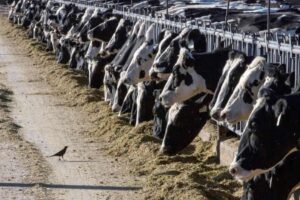
On a US dairy farm, working in the milking parlor can mean seven-day weeks, 12-hour shifts and intimate contact with cows and everything they expel.
“When you disconnect the machine from the udder, it can shoot milk in your face,” said José Martínez, a former dairy worker and United Farm Workers advocate based in Washington state. “And there’s no time or place to eat. So we ate our tacos in spare moments with cow shit on our hands.”
Conditions on US dairy farms are in the spotlight since the H5N1 influenza virus, which has decimated bird populations around the world, jumped species and adapted to spread between cows. That makes dairy farm workers the frontline for spillover infections into humans.
As of 24 May, there are 58 known infected herds across the US. Two human infections have been documented, in dairy farm workers in Texas and Michigan. But there are anecdotal reports of other farm workers with mild symptoms.
One-off spillover infections between species are not in themselves enough to cause a pandemic. That would require the virus to adapt to spread easily between humans, as it has to spread between cows.
The probability of the virus accumulating the right combination of mutations to do this is low. But influenza is known for its ability to evolve, and a sluggish public health response is giving this H5N1 an opportunity to become entrenched in cows – a species that has a lot of close contact with humans.
“Just because we had a coronavirus pandemic doesn’t mean we’re done,” said Michael Osterholm, an epidemiologist at the University of Minnesota. “The pandemic clock is ticking. We just don’t know what time it is.”
Since H5N1 was discovered in US cows, scientists have scrambled to define the situation.
Yet many unknowns remain, for example how many states and herds are affected, how it spreads between cows, how the two human cases were infected – and whether they are the only ones.
